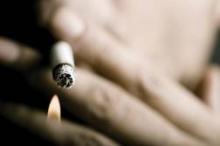More than 18% of smokers who were inpatients at a large urban teaching hospital reported that they smoked during their stay, even though smoking was prohibited in the hospital buildings, according to a report published online Nov. 5 in the Archives of Internal Medicine.
Receiving nicotine replacement therapy at admission delayed but did not prevent these patients from smoking eventually, said Susan Regan, Ph.D., of the tobacco research and treatment center at Massachusetts General Hospital, Boston, and her associates.
Virtually all hospitals now prohibit smoking indoors, but many allow patients, as well as staff, to smoke outdoors on the hospital grounds. "The fact that patients may go outside to smoke, especially without supervision or in inclement weather, raises safety concerns," the investigators said.
It also may compromise quality of care and hospital efficiency if patients aren’t available for assessments or treatments because they’re outside smoking. And smoking during a hospitalization can delay recovery and impair wound healing. In addition, inpatients who duck outside to smoke "deprive themselves of an opportunity to initiate a quit attempt in a supportive, smoke-free environment," Dr. Regan and her colleagues said.
They studied inpatient smoking during a 3-year period at the hospital, where smoking is banned indoors and outdoors except for two outdoor shelters. The study subjects were 2,185 adult inpatients who were automatically referred to the facility’s tobacco treatment service at admission, which facilitated the ordering of nicotine replacement therapy and provided a bedside counselor to assist in managing nicotine withdrawal.
The counselor also gave brief (5 minutes or less) advice on quitting smoking, as well as longer (20 minutes) cessation counseling for patients who expressed interest in quitting. The counseling included motivational interviewing, plus discussion of behavioral strategies and the use of medications to maintain smoking abstinence.
Patients’ in-hospital smoking was assessed by self-report during their hospital stays and telephone follow-up in the 2 weeks after discharge. Median length of stay was 5 days, and 62% of the subjects received nicotine replacement therapy; one-third received the therapy on the first day of their stay. The mean patient age was 53 years, and 58% of the study subjects were men.
Overall, 18.4% of these patients reported that they smoked at some time during their hospital stay. Patients were more likely to report such smoking if they were younger, had longer hospitalizations, and had no plans to quit.
Patients who received nicotine replacement therapy on admission were less likely to smoke early in their hospital stay, but they resumed smoking later on in their stay at the same rate as did patients who never received the treatment. "Patients with longer stays might require increasing nicotine dose or supplementation of patch with shorter-acting forms of nicotine replacement therapy" such as nicotine gum or lozenges, the investigators said (Arch. Intern. Med. 2012 [doi:10.1001/2013.jamainternmend.300]).
The number of cigarettes that subjects typically smoked was not as predictive of smoking during hospitalization as was the intensity of their cigarette cravings.
"It may be difficult to predict the intensity of cravings during an admission from preadmission smoking level, due to individual variability in response to illness and the hospital environment. Routine ongoing assessment of cigarette craving, although more time-consuming, might be a more effective means of identifying patients who will have difficulty remaining abstinent during their hospital stay and assist in titrating nicotine dose for patients already receiving nicotine replacement therapy," Dr. Regan and her associates said.
Patients hospitalized during the winter months were less likely to smoke (14.4%) than were those hospitalized during the other seasons (19.7%). This is probably because of the severity of Boston’s winters, but it also may be related to a seasonal difference in case mix, researchers said. This study did not assess discharge diagnoses, so the latter possibility couldn’t be examined, they noted.
This study was limited in that it relied on patient self-report and subjects may have been reluctant to disclose their smoking or may not have remembered it accurately. In addition, the study was restricted to patients who received counseling from the hospital’s tobacco treatment service and who responded to telephone follow-up, which likely introduced a response bias to the data.
This study was supported by the National Heart, Lung, and Blood Institute. Dr. Regan reported no financial conflicts of interest, but one of her associates reported ties to Nabi Biopharmaceuticals, Pfizer, and Alere Wellbeing.


